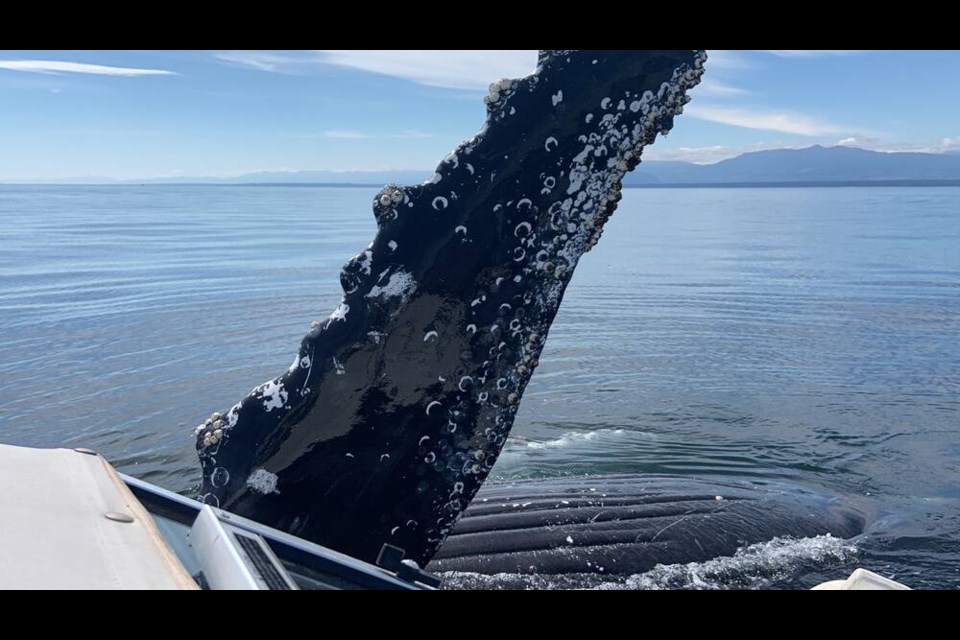A Cumberland family out on their boat hoping to spot a whale off Vancouver Island this week got a lot more than they bargained for.
A humpback whale took a shine to the vessel and stayed within a few feet of the family boat for more than hour.
About “the size of school bus,” the humpback swam under and on either side of the family’s 19-foot boat, spinning around and slapping its massive tail and front fins, often seeming like “it was waving to us,” said Aleks Mounts, who filmed the encounter and posted it to his YouTube channel.
“It just didn’t want to leave,” said Alex Bowman, Mounts’ ex-wife and mother of their two sons, ages 9 and 13. “It looked as if it was giving us high-fives.”
Mounts said it was a warm and calm day on the water on Tuesday northeast of Campbell River when he spotted the whale about 100 metres away.
“I immediately killed the engine because I wanted to respect the rules about whales,” he said.
But the humpback dived and surfaced about a minute later right under their boat. He figured the whale would move on, but it stayed. The family was initially “terrified” of the giant creature, which could have flipped the boat out of the water, Mounts said.
He was reluctant to restart the engine for fear of the propeller hurting the humpback.
But the encounter seemed to get friendly, quite quickly.
The whale swam under the boat and along both sides, then spun and slapped its tail and flippers within inches of the boat. It often surfaced and sprayed the family from its blowhole. “I can taste it … his breath isn’t bad,” Mounts said while filming.
He said the whale only made contact with the boat at one point with its barnacle-encrusted fin, leaving some scratches and a slightly bent rail.
“He would wave to us and then flop it hard into the water. He was doing these yoga moves. It was crazy, something none of us have ever seen,” said Mounts.
“I can’t believe how gentle is is, and how aware it is.”
Bowman said: “We did feel vulnerable in the boat, but it was a gentle giant who wanted to hang out with us. It seemed like he was more curious of us than we were of him.”
The whale was later confirmed as a young male named Neowise. Humpbacks are identified by the patterns on the underside of their flukes, which are unique like human fingerprints.
Andrew Trites, director of marine mammal research at the University of British Columbia, said boat encounters with humpbacks are not common. But as the species continues a great comeback from the whaling slaughter of the early 1900s — and extinction in the Salish Sea — he expects more close encounters could happen.
The whale might have been attracted to the boats depth finder or fish finder, which uses sound waves to determine the depth of the water, Trites said.
The sound waves are similar to the vocalizations that whales use to communicate with each other, he said, and scientists are studying a possible connection between depth finders and whales.
“It’s a high-frequency sound, a narrow beam that doesn’t hurt the whales, but they are very vocal and like to communicate,” said Trites.
Although humpbacks in B.C. waters are here to feed, the young whale could have understood the depth finder as “a love song” and could have been “getting pleasure as part of a social interaction” from hearing the sound waves, Trites said.
“Otherwise, a boat is an inanimate object,” he said.
Mounts said the depth finder was on when he saw the whale, and went off when he turned off the boat engine.
Trites worries increasing encounters could pose “great risks” for boaters. Male humpbacks typically weigh more than 10,000 kilograms and they are not often in control of their massive bodies and “gangly” flippers.
“They’re giant, but they are quite clumsy,” said Trites, adding boats could be destroyed and occupants placed at great risk if a fluke or flipper comes crashing down.
He recommends boaters turn off depth sounders when they see whales and, if they are too close, try to move away to keep a safe distance.
Populations of the Humpback in the North Pacific are increasing at a remarkable rate.
Naturalists aboard whale-watching vessels reported 21 new calves last summer and fall — the largest nursery batch on record and nearly double the previous high of 11 identified the previous year, according to the Center for Whale Research in Washington.
Populations were reduced worldwide by as much as 95% until a final moratorium on harvesting the species for meat and oil was introduced in 1985 by the International Whaling Commission.
Humpbacks have been protected in Canada since 1966. Before then, according to a recent report by Ocean Watch, at least 5,600 humpbacks were harvested from whaling stations along the B.C. coast starting in 1908, decimating the population.
The Salish Sea is one of the last historical areas that the humpbacks have “re-occupied” since the whaling days, starting about 20 years ago with a single whale. Others, and their calves, have followed.
Ocean Watch said the inland waters of the Strait of Georgia extending south to Puget Sound is likely where “a small and possibly resident population of humpbacks was extirpated by 1909.”
As humpbacks start to re-populate a historical summer feeding area in the Salish Sea, Trites said, it’s essential that humans develop a respectful relationship on how they interact with the species.
>>> To comment on this article, write a letter to the editor: [email protected]



